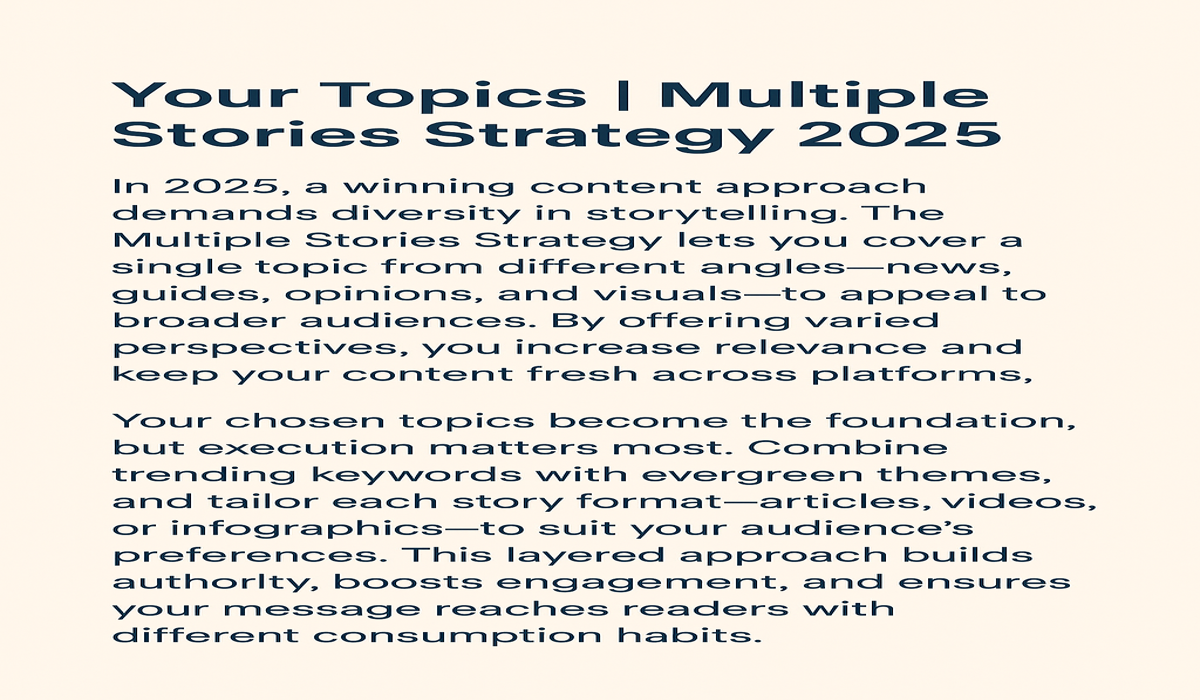delivering diverse stories around a central theme. It allows creators to explore different angles, formats, and perspectives, keeping audiences engaged. By blending various storytelling methods, this strategy ensures content feels fresh and relatable. In 2025, it’s becoming essential for standing out in a competitive digital landscape.
This method not only boosts audience retention but also enhances brand identity through consistency and variety. It encourages creators to address multiple audience segments without losing focus. Leveraging text, video, audio, and interactive elements, the strategy adapts to evolving user preferences. As trends shift, the Multiple Stories Strategy helps content remain relevant, impactful, and highly shareable.
Multi-Story Approach
The Multi-Story Approach is a modern content strategy that delivers multiple narratives around one main theme. It offers diverse perspectives, ensuring the audience stays engaged and curious. By exploring different story angles, brands can connect with a wider audience segment. This flexibility allows content to remain fresh and adaptable to trends.
It thrives on blending various formats like blogs, short videos, podcasts, and interactive posts. Each format speaks to a different type of consumer, boosting overall reach. The approach also encourages cross-platform storytelling for greater visibility. In 2025, this method is essential for standing out in the competitive content market.
Why Traditional Content Falls Flat in 2025
In 2025, audiences are more selective about where they give their attention. Traditional single-format content often feels repetitive and lacks personalization. Viewers expect dynamic, interactive, and emotionally engaging material. Without that, they quickly move on to something else.
What Makes “Multiple Stories” a Game-Changer
The “Multiple Stories” strategy transforms one idea into several captivating narratives. Each story angle speaks to different emotions, needs, or curiosity points. This keeps audiences returning for more and builds stronger loyalty. It also allows brands to stay relevant across different trends.
What is the “Your Topics | Multiple Stories” Method?
The “Your Topics | Multiple Stories” method is a content strategy that takes one theme and explores it through various narratives. Each story presents a fresh perspective, keeping the audience hooked. It’s designed to serve different interests while staying connected to a central topic. This ensures both variety and consistency in content delivery.
Defining the Multi-Narrative Framework
The Multi-Narrative Framework is the structured way of organizing several storylines around one subject. It ensures each narrative adds value while contributing to the bigger picture. This prevents content from feeling repetitive or one-dimensional. Instead, it offers layers of depth for the audience to explore.
How It Differs from Standard Blogging or Vlogging
Standard blogging or vlogging often follows a single-story format, focusing on one perspective per piece. The Multi-Story method, however, offers multiple viewpoints on the same topic. This gives audiences more reasons to stay engaged and return for more. It’s like reading a whole book instead of just one chapter.
Real-Life Example of the Approach in Action
Imagine a travel blogger covering “Paris in Spring.” Instead of one post, they create multiple stories—food tours, hidden spots, cultural festivals, and budget travel tips. Each narrative adds a unique layer, attracting different audience types. This gives followers more ways to connect with the content.
Why This Strategy Works So Well in 2025
The digital space in 2025 is more crowded than ever, and audiences demand variety. The Multi-Story approach keeps content fresh, making it harder for viewers to lose interest. By delivering multiple angles, it offers value to different audience segments at once. This versatility makes it a winning strategy for the year ahead.
Audience Behavior Trends: Skimming, Relevance & Empathy
Audiences now skim more than they read word-for-word, seeking immediate value. A multi-story format offers bite-sized yet relevant narratives that cater to this behavior. Each story captures attention without overwhelming the viewer. This keeps audiences engaged for longer periods.
Google’s Helpful Content System Alignment
Google’s Helpful Content system rewards material that truly serves user needs. Multi-story content achieves this by offering in-depth, diverse, and valuable perspectives on one topic. It signals to search engines that your content is rich and comprehensive. This boosts visibility and ranking potential.
Emotional Resonance + Contextual Depth = Retention
People remember content that makes them feel something and teaches them something new. The Multi-Story method combines emotional storytelling with rich context. This ensures your audience not only clicks—but stays. Retention becomes a natural result of this balance.
Core Elements of Multi-Story Content

At its heart, multi-story content is about taking a single theme and exploring it from multiple angles. This creates variety while keeping the central focus intact. Each narrative offers a new hook, appealing to different audience interests. The result is deeper engagement and a richer storytelling experience.
Narrative Layering: Crafting Multiple Voices
Narrative layering involves presenting different perspectives or voices on the same topic. This can include expert opinions, personal stories, data insights, or fictional elements. It gives content more texture and authenticity, making it relatable to various audience types.
Diverse Formats: Text, Video, Podcast, Visuals
Different people prefer different ways of consuming content. Multi-story strategies leverage this by delivering material in text, video, podcast, and visual formats. This ensures your message reaches audiences wherever they are most comfortable.
Audience-Based Context: Writing for Real Needs
Content succeeds when it directly addresses the audience’s problems, questions, and desires. Audience-based context means tailoring stories to real-life situations and needs. This creates trust and makes content feel genuinely valuable.
Building a Winning Multi-Story Content Strategy
A winning multi-story content strategy begins with selecting a core topic that has enough depth for multiple narratives. From there, map out subtopics, angles, and storytelling formats that appeal to different audience segments. This ensures you cover the subject comprehensively without becoming repetitive. The goal is to keep each piece connected yet distinct.
Step 1: Choose a Topic with Emotional or Social Depth
Not all subjects are suitable for a multi-story approach—select those with genuine meaning. Themes like sustainability, digital privacy, or workplace well-being provide multiple layers to explore.
They connect emotionally, spark curiosity, and invite dialogue. Such topics naturally lead to rich, engaging narratives that resonate with audiences.
Step 2: Develop 4–6 Story Angles with Different Voices
Every story should offer a unique take. One might focus on personal impact, another on hard data. Some can inspire action, while others break down analysis.
Here’s an example breakdown:
| Story Angle | Format | Target Audience |
| Freelancer balancing life | Blog | Young professionals |
| Teens learning budgeting | Short video | High school/college |
| Remote team productivity | Podcast | Project managers |
| Shifting corporate values | LinkedIn post | Business leaders |
Step 3: Match Content to the Marketing Funnel
Map each piece of content to the customer journey. At the awareness stage, lead with emotion. In the consideration stage, offer guidance. At the decision stage, show proof.
Example funnel structure:
| Funnel Stage | Goal | Story Type |
| TOFU | Inspire | Relatable story |
| MOFU | Educate | How-to guide |
| BOFU | Convince | Success case study |
Step 4: Align All Stories with Your Brand Voice
Even with different angles and formats, the core tone should be unmistakably yours. A style guide helps unify word choice, imagery, and brand colors.
This creates cohesion and builds brand familiarity. Over time, your audience instantly recognizes and trusts your content.
Step 5: Interlink Strategically for SEO Authority
Use a main “pillar” page as the central hub, linking to all related stories. Also, connect each story to at least one other piece for a web-like structure.
This improves user navigation and signals topic expertise to search engines. Strong interlinking can boost rankings and keep readers exploring longer.
Examples of Multi-Story Mapping
Case Study: Social Media and Generational Impact
A single theme like “social media” can be told through many lenses. For Gen Z, it could focus on trends and identity. Millennials might be discussed in terms of digital balance and mental health. For older generations, the focus could shift to learning curves and connection with family.
By exploring each viewpoint, the topic becomes richer and appeals to a broader audience. The variety of perspectives creates an emotional bridge between generations. This approach also highlights universal themes while keeping each narrative distinct.
Case Study: Remote Work Culture from Different Viewpoints
Remote work is more than a business model—it’s a lifestyle change. For employees, it could be about flexibility, burnout, or work-life integration. For managers, it’s productivity tracking, communication tools, and team culture. For clients, it’s the reliability and quality of service.
Story Formats Table: Persona – Format – Goal
| Persona | Format | Goal |
| Startup founder | Podcast | Share insights |
| College student | Instagram Reels | Inspire action |
| HR director | LinkedIn Post | Educate peers |
| Parent working from home | Blog Post | Provide solutions |
Key Benefits of the “Multiple Stories” Framework
The “Multiple Stories” framework allows creators to explore one idea through diverse angles, making content richer and more appealing. It’s designed to keep audiences engaged longer while providing fresh perspectives each time they visit. This variety caters to different learning styles and preferences. As a result, your content feels dynamic instead of repetitive.
By combining different voices, formats, and emotional tones, it builds stronger audience relationships. The framework also naturally supports SEO through related topics and internal linking. Over time, it positions your brand as a trusted, go-to authority. In 2025, this mix of depth and adaptability is a major advantage.
Higher Engagement and Time-on-Page
Offering multiple narratives around a single theme encourages visitors to explore more of your content. Each story provides a new reason for them to stay longer. This extended interaction signals value to both the audience and search engines.
Broader Keyword Reach and Semantic SEO Boost
Covering a topic from different angles allows you to naturally include a wider range of keywords. This enhances your visibility for related searches without forced optimization. The result is a stronger presence in both broad and niche queries.
Easier Repurposing Across Platforms
Because each story stands on its own, repurposing becomes effortless. A blog post can transform into a short video, a podcast segment, or a carousel post. This maximizes reach without requiring entirely new content each time.
Builds Emotional and Psychological Connection
Multiple stories allow you to connect with your audience on various emotional levels. Some may resonate with personal experiences, while others connect through data or shared challenges. This makes your content more relatable and human.
Best Tools to Scale Your Strategy

Scaling a multi-story content approach requires the right mix of planning, optimization, and creative tools. The right toolkit helps streamline workflows, improve collaboration, and maintain quality. From organizing ideas to publishing across platforms, every step benefits from strategic automation. In 2025, tool integration is key to efficiency.
By combining project management, SEO analysis, and design platforms, creators can deliver more stories in less time. These tools also ensure consistency across formats and channels. With the right setup, scaling doesn’t mean sacrificing creativity or quality.
Content Planning Tools (Notion, Trello, etc.)
Tools like Notion and Trello make it easy to plan and track your multi-story strategy. They allow you to organize content calendars, assign tasks, and monitor progress. This is especially useful when coordinating across teams or freelancers.
SEO Optimization Tools (Frase, Surfer, Clearscope)
SEO-focused platforms like Frase, Surfer, and Clearscope help identify keyword opportunities and optimize content depth. They analyze search intent, competition, and semantic relevance to boost rankings.
Design & Multimedia Tools (Canva, Descript, Tableau)
Visual and multimedia tools like Canva, Descript, and Tableau elevate your storytelling. Canva simplifies graphic design for blog visuals, social media posts, and infographics. Descript streamlines audio and video editing, while Tableau transforms data into engaging visuals.
Pro Tips for Future-Proof Content
Future-proofing your content means making it adaptable to evolving technology, search algorithms, and audience expectations. This requires strategic optimization, flexible formats, and a commitment to accessibility. Every piece should be designed to remain relevant and discoverable long-term.
By incorporating structured data, optimized meta tags, and mobile-first design, you ensure better visibility and user experience. These elements work together to boost engagement, rankings, and retention in an ever-changing digital space.
Use Structured Data and Semantic Markup
Structured data helps search engines understand your content contextually. Using schema markup, you can highlight elements like FAQs, reviews, events, or product details. This increases the chance of rich snippets in search results.
Optimize Meta Tags per Story Angle
Each story in your multi-story framework should have its own unique meta title and description. Tailoring these for each angle improves click appeal and keyword targeting. It also ensures your pages don’t compete with one another in search results.
Keep Mobile-First and Accessible Design in Mind
With most users browsing on mobile, your content must be designed for smaller screens first. This means responsive layouts, fast loading times, and clear typography.
Frequently Asked Questions
What is the “Multiple Stories” content strategy?
It’s a method of exploring one topic through several narratives and formats to engage diverse audiences.
Why is this strategy effective in 2025?
It matches modern audience behavior, supports SEO, and keeps content fresh across platforms.
How many story angles should I create per topic?
Ideally, 4–6 distinct angles to cover different perspectives without overlap.
Does multi-story content help with SEO?
Yes, it boosts keyword variety, internal linking, and topical authority.
Can I repurpose multi-story content across platforms?
Absolutely, and it’s one of the key benefits for scaling reach and engagement.
Conclusion
The Multi-Story Content Strategy is more than just a creative approach—it’s a complete framework for building lasting audience engagement. By presenting multiple perspectives on a single topic, you keep content fresh and appealing to different audience segments. This variety boosts SEO, increases time-on-page, and strengthens brand trust. In the fast-changing 2025 digital landscape, such adaptability is essential.
When executed with strategic planning, consistent brand voice, and smart repurposing, this method can transform your content output. It allows you to maximize the value of each idea while expanding your reach across platforms. The result is a sustainable, future-proof system for storytelling. By embracing this approach, you set your brand apart and ensure your content thrives well into the future.

Jane Doe, founder of CaptionBio.co.uk, crafts heartfelt messages to inspire love, gratitude, and daily positivity. Let’s spread kindness through words!






